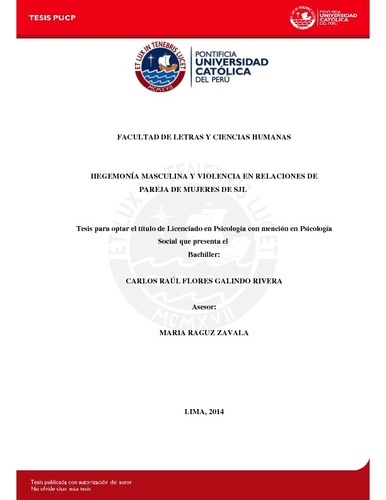| dc.contributor.advisor | Raguz Zavala, María de las Mercedes | es_ES |
| dc.contributor.author | Flores Galindo Rivera, Carlos Raúl | es_ES |
| dc.date.accessioned | 2014-10-02T14:35:23Z | es_ES |
| dc.date.available | 2014-10-02T14:35:23Z | es_ES |
| dc.date.created | 2014 | es_ES |
| dc.date.issued | 2014-10-02 | es_ES |
| dc.identifier.uri | http://hdl.handle.net/20.500.12404/5606 | |
| dc.description.abstract | Esta investigación describe cómo se ejerce el poder masculino en las relaciones de pareja de un grupo mujeres de San Juan de Lurigancho. Estas mujeres han mantenido o mantienen relaciones de “violencia de pareja íntima”. El proceso de investigación ha considerado necesario, en primer lugar, identificar el lugar del varón en relación al poder al que las mujeres de este grupo se someten. En segundo lugar, describir los mecanismos para el ejercicio del poder sobre estas mujeres. En tercer lugar, describir las posturas que estas mujeres adoptan frente al ejercicio del poder masculino. Se enmarcó los objetivos de investigación dentro de la teoría de género, asumiendo que es posible observar las relaciones de género como relaciones de poder. Así se empleó un diseño cualitativo tomando como herramienta para recoger la información los sistemas conversacionales propuestos por Gonzáles Rey (2007). Se encontró que existe una masculinidad hegemónica en todas las participantes y se identificó cinco mecanismos a través de los cuales se ejerce el poder hegemónico masculino sobre estas mujeres. Finalmente se identificó que el poder hegemónico no es absoluto y existe un límite subjetivo y particular en cada mujer que puede poner fin a una relación violenta. | es_ES |
| dc.description.abstract | This research describes the execution of male power in couple relationships of women in San Juan de Lurigancho, who maintain or maintained violent relationships with their intimate partners. First, the relation of man to the power to which women in this group are subjected to is identified. Second, the mechanisms for the use of power over these women are described. Third, the positions that these women adopt against male power is described. Research objectives are framed within gender theory, therefore assuming that it is possible to analyze gender relations as power relations. A qualitative design is used that uses the conversational systems proposed by Rey Gonzales (2007) as a tool to collect information. Evidence of hegemonic masculinity was found in the experience of all participants, and five mechanisms were identified through which the male hegemonic power is executed over these women. Finally, it was found that the hegemonic power is not absolute and that there is a subjective and particular limit in each woman that, when meet, can end a violent relationship. | es_ES |
| dc.language.iso | spa | es_ES |
| dc.publisher | Pontificia Universidad Católica del Perú | es_ES |
| dc.rights | Atribución-NoComercial-SinDerivadas 2.5 Perú | * |
| dc.rights | info:eu-repo/semantics/openAccess | es_ES |
| dc.rights.uri | http://creativecommons.org/licenses/by-nc-nd/2.5/pe/ | * |
| dc.subject | Relaciones de pareja | es_ES |
| dc.subject | Género | es_ES |
| dc.subject | Violencia familiar | es_ES |
| dc.title | Hegemonía masculina y violencia en relaciones de pareja de mujeres de SJL | es_ES |
| dc.type | info:eu-repo/semantics/bachelorThesis | es_ES |
| thesis.degree.name | Licenciado en Psicología Social | es_ES |
| thesis.degree.level | Título Profesional | es_ES |
| thesis.degree.grantor | Pontificia Universidad Católica del Perú. Facultad de Letras y Ciencias Humanas | es_ES |
| thesis.degree.discipline | Psicología Social | es_ES |
| renati.discipline | 313066 | es_ES |
| renati.level | https://purl.org/pe-repo/renati/level#tituloProfesional | es_ES |
| renati.type | http://purl.org/pe-repo/renati/type#tesis | es_ES |
| dc.publisher.country | PE | es_ES |
| dc.subject.ocde | http://purl.org/pe-repo/ocde/ford#5.01.00 | es_ES |






